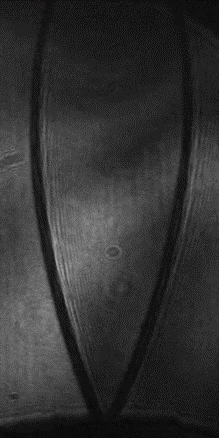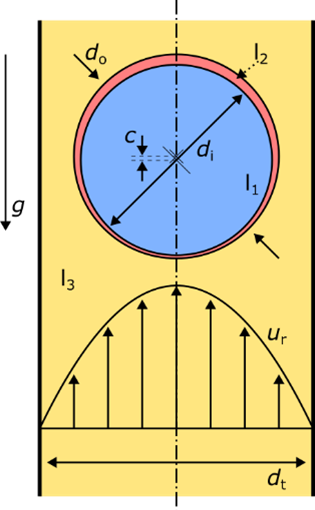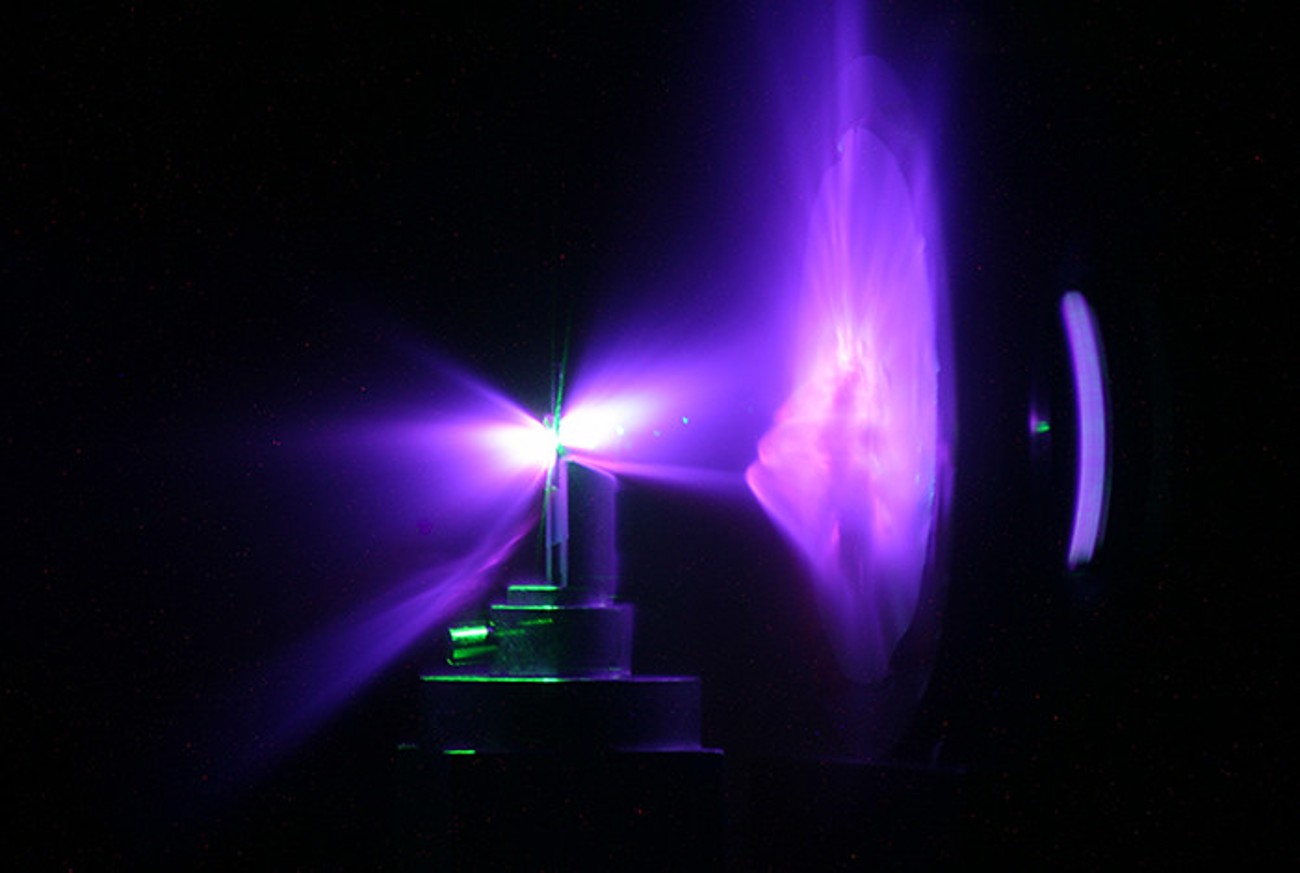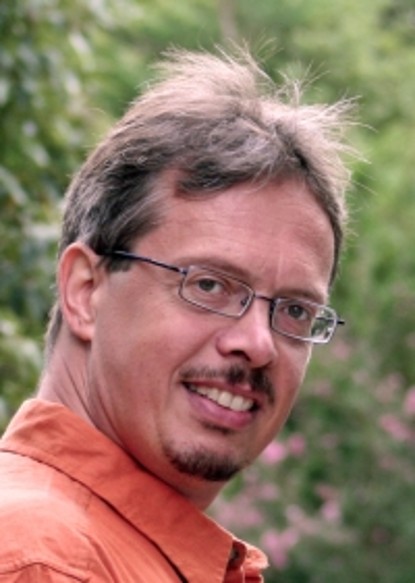Masterarbeit
Motivation
X-ray sources play a pivotal role in diverse applications, spanning from medical diagnostics and industrial container inspection to non-destructive evaluation of critical components. The pressing demand from both society and industry for a compact yet potent MeV X-ray source has long been a challenge for conventional methodologies. This is where high-power lasers emerge as potential game-changers, offering the prospect of affordable, transportable high-energy X-ray sources.Central to this innovation is laser-driven particle acceleration, specifically the target normal sheath acceleration (TNSA) process and the Laser Wakefield acceleration (LWFA) process. While their conventional counterparts require large particle accelerators, these methods generate high-energy X-rays by swiftly accelerating electrons and inducing bremsstrahlung emission within a mere centimeter of space.
While the immense potential of these sources is recognized, the crucial task at hand is to identify precise laser parameters that harmonize with their intended applications. This master thesis opportunity is an invitation to embark on a journey of exploration. By utilizing simulations and conducting thorough literature research, you will uncover the optimal laser parameters, a key enabler for constructing a laser-driven X-ray source. The ultimate goal? Maximizing X-ray production within the energy range of 3 to 10 MeV.
Tasks
- Literature research on existing short pulse laser systems between 10 mJ to 1 J and their pulse parameters and cost.
- evaluation based on literature and simulations which laser-acceleration mechanism is better suited for hard x-ray production.
- Particle-in-Cell and Monte-Carlo-based simulations are used for a parameter scan to optimize x-ray production between 3 and 10 MeV.
- Evaluation of which laser-target parameter combination has the highest potential to be used as a laser-driven x-ray source.
- Use Monte-Carlo codes to simulate the source performance for the most relevant application.
Haben wir ihr Interesse geweckt? Dann schreiben Sie bitte eine Mail an markus.roth@physik.tu-… und gschaumann@ikp.tu-….

Masterarbeit
Neben Linearbeschleunigern kann für die Beschleunigung von Ionen z.B. auch der TNSA-Mechanismus genutzt werden, bei welchem MeV Ionen mithilfe eines Petawatt-Lasersystems aus einem μm dicken Target beschleunigt werden.
Für die Laser-Ionen-Beschleunigung bei hohen Repetitionsraten werden Targetsysteme benötigt, welche neue Targets mit einer entsprechenden Rate zur Verfügung stellen können. Ein vielversprechender Ansatz ist hierbei die in situ Produktion des Targets, z.B. bei einem sogenannten Fluidblatt. Dieses kann durch die kontrollierte Kollision zweier einzelner Flüssigkeitsjets erzeugt werden.
Da die Energie der beschleunigten Ionen unter anderem von der Dicke des Targets am Fokuspunkt des Lasers abhängt, ist deren Kenntnis entscheidend für die Interpretation der Ionenspektren. Im Rahmen dieser Arbeit soll ein gepulstes Interferometer in die Shadowgraphie des Interferometers integriert werden. Dieses soll die bisherigen Möglichkeiten zur Dickenmessung durch die Option ergänzen die gesamte Dickenverteilung des Leafs zwischen einzelnen Laserschüssen zu vermessen und mittels einer Verschiebung des Delays auch die Einflüsse der Laser-Target-Wechselwirkung zu studieren.
Die Daten dieser Messungen zur Dickenverteilung im Betrieb sollen anschließend genutzt werden, um als Kriterium der Stabilität des Targetsystems zu fungieren.
Im Rahmen dieser Arbeit soll zuerst das Interferometer modelliert und die Komponenten hierfür ausgewählt werden. Der Aufbau kann dann zuerst im Labor getestet und optimiert werden. Anschließend kann das Interferometer bei einer Strahlzeit im realen Betrieb getestet werden.
Haben wir ihr Interesse geweckt? Dann schreiben Sie bitte eine Mail an markus.roth@physik.tu-… und gschaumann@ikp.tu-….
Masterarbeit
At a time when climate change is becoming more and more visible and energy crises are shaking society, the call for a clean, renewable energy source is getting louder and louder. While solar and wind power contribute their share to the energy transition, their contribution is subject to strong fluctuations. Therefore, we need a CO2-neutral alternative that is permanently ready to perform. Nuclear fusion is seen as the Holy Grail of the energy industry but has so far been seen as far from an actual application. This changed last year when a burning fusion plasma was ignited for the first time at the National Ignition Facility (NIF) in Livermore using laser-based inertial fusion. Now the race for enabling fusion as a power source is on. The company Focused Energy uses laser-driven inertial confinement fusion similar to what happened at NIF but utilizes an approach, that is projected to be more energy efficient, called Proton Fast Ignition (PFI). In PFI a fuel target is first compressed to high densities (hundreds of g/cc) by ablating the outer target shell using a set of high-energy lasers. This compressed fuel is then rapidly heated by an ion beam generated using short-pulsed lasers. However, during compression the influence of processes called Laser Plasma Instabilities (LPI) can diminish laser-to-fuel coupling and lead to fuel preheating, which is detrimental to fuel compression. Reducing the influence of these LPI is therefore beneficial to achieving energy efficient compression. In order to study these phenomena and possible mitigation techniques, Focused Energy conducts experiments at high energy laser facilities. Since the created plasma, in this regime of approximately nanosecond scale time dynamics and micrometer scale lengths, behaves close to a radiating fluid radiation-hydrodynamic simulations can be consulted. These simulations help to understand the scaling of experimental campaigns.
During the proposal, radiation-hydrodynamic simulations for an experimental campaign on LPI should be set up, run, and analyzed. The simulations will be run with a code called FLASH. The master thesis will be conducted together with Focused Energy, of which your supervisor Prof. Markus Roth is a founding member. Since radiation-hydrodynamics simulations are a versatile tool, we have two different projects to choose from, for the Master Thesis itself. The first project would model ablation plasma scale lengths for a different upcoming experimental campaign and could include supporting experiment design by using different plasma shaping methods. The second project consists of writing an initialization routine for FLASH to load complex multi-material target structures into simulations and analyze the influence of certain structures on shock propagation and potential instability seeding.
Useful skills to bring or develop:
- Programming, plotting, and evaluating data with Python
- Writing small Fortran routines
- Motivation to learn the physics of radiation-hydrodynamics
If you are interested in working with us on this project, please contact markus.roth@physik.tu-… and mbroenner@ikp.tu-….
Bachelor- / Masterarbeit
Motivation
Der LOEWE Schwerpunkt Nukleare Photonik ist ein Gemeinschaftsprojekt von TEMF, IKP und der GSI. Im Rahmen des LOEWE Schwerpunktes soll eine laserbasierte Neutronenquelle entwickelt werden, um diese zu optimieren sollen Nukleare Monte Carlo Codes wie z.B. MCNP, PHITS, GEANT4 oder auch FLUKA verwendet werden.
Für diese Entwicklungen wurden experimentelle Daten zur Neutronen-Erzeugung unter anderem am COSY-Beschleuniger in Jülich aufgenommen. Experimentelle Daten sollen dann schnell und effizient evaluiert werden. Das Ziel ist, alternative Methoden zur n/γ Diskriminierung, basierend auf Methoden des Supervised Learning, zu entwickeln und zu vergleichen. Die Analyse kann durch komplementäre Monte Carlo Simulationen ergänzt werden.
Aufgabenbeschreibung
Aufgaben B.Sc.:
- Konzeptionieren der Evaluationsmethoden
- Evaluation von n/γ Daten
Zusätzliche Aufgaben M.Sc.:
- Komplementäre Monte Carlo Simulationen
- Literaturvergleiche und Ersatzmodelle finde
Ziele:
- Analyse der Neutronendaten
- Vergleich mit den konventionellen Auswertemethoden (siehe Abb)
Haben wir ihr Interesse geweckt? Dann schreiben Sie bitte eine Mail an markus.roth@physik.tu-… und gschaumann@ikp.tu-….
Bachelor- / Masterarbeit
Motivation
Target Normal Sheath Acceleration (kurz TNSA) ist der am besten untersuchte Prozess für die Beschleunigung von Ionen aus einem Plasma, Experimente gibt es dazu seit den frühen 2000er Jahren. In dieser Arbeit soll der Einfluss des Vorplasmas auf die Ionenbeschleunigung mit 1D PIC untersucht werden. Die Aussage, „Desto weniger Vorplasma, desto besser für den Prozess.“ soll verifiziert oder falsifiziert werden. Für den Fall eines High-Rep Rate Liquid Leaf Targets sollen optimale Parameter oder Bedingungen hergeleitet werden.
Aufgabenbeschreibung
Aufgaben B.Sc.:
- Bestimmung relevanter Parametersätze
- Simulationsmodelle entwickeln und Testen
- Optimierung der bestimmten Parametersätze
Zusätzliche Aufgaben M.Sc.:
- Ergänzung durch 2D Simulationen
- Herleitung von Ersatzmodellen
- Sensitivitäsanalysen
Ziele:
- Die Bewertung der Bedeutung des Vorplasmas.
- Die Vorhersage von Änderungen im Teilchenspektrum.
Voraussetzungen
Erfahrung im Programmieren, Python und Linux ist empfehlenswert.
Literatur:
https://doi.org/10.1103/PhysRevResearch.4.013065
https://doi.org/10.1017/hpl.2019.35
Haben wir ihr Interesse geweckt? Dann schreiben Sie bitte eine Mail an markus.roth@physik.tu-… und gschaumann@ikp.tu-….
Bachelor- / Masterarbeit
Motivation
Der LOEWE Schwerpunkt Nukleare Photonik ist ein Gemeinschaftsprojekt von TEMF, IKP und der GSI. Die Nachfrage nach Neutronen zur Anwendung in Forschung und Entwicklung hat in den letzten Jahren stark zugenommen. Gleichzeitig werden aber die Forschungsreaktoren, welche die Neutronen bereitstellen abgeschaltet. Im Rahmen des LOEWE Schwerpunktes soll eine laserbasierte Neutronenquelle entwickelt werden, um diese zu optimieren sollen Nukleare Monte Carlo Codes wie MCNP, PHITS oder auch FLUKA verwendet werden.
Da diese Codes bezüglich ihrer Inputfiles und Geometriedefinition unterschiedliche Ansätze verfolgen sind die Simulationen nicht leicht in andere Software übertragbar. Am CERN wurde die GDML entwickelt um die Geometrien geschlossen ohne größeren Aufwand transformieren zu können. Im Rahmen dieser Arbeit soll GDML für andere verbreitete Softwaresuiten implementiert und für einen Benchmark von verschiedenen Geometrien für Neutronenkonverter verwendet werden.
Aufgabenbeschreibung
- Implementation von GDML für verschiedene Codes
- Verifikation der Korrektheit konvertierter Modelle
- Modellierung verschiedener Geometrien für Neutronenkonverter
Ziele:
- Analyse des Neutronenspektrums für verschiedene Konvertergeometrien
Voraussetzungen
Für diese Arbeit ist Erfahrung im Programmieren von Python nötig. Vorwissen in Markup Sprachen oder CAD ist wünschenswert.
Haben wir ihr Interesse geweckt? Dann schreiben Sie bitte eine Mail an markus.roth@physik.tu-… und gschaumann@ikp.tu-….
Bachelor- / Masterarbeit
Motivation
Der entwickelte pyRES (pythonic Radiochromic film Evaluation Software) wurde entwickelt um die Auswertung von RCF stacks für laserbeschleunigte Ionen zu verbessern. Version 1.0 die verfügbar ist automatisiert bereits die Segmentierung der RCFs und liefert die ersten Ansätze zur Auswertung.
Einige Module für eine effektive Auswertung fehlen und sollen entwickelt und getestet werden. Dies ermöglicht konsistentere Auswertung von Daten und potentielle Anwendungen in datengestützte Modellierung.
Aufgabenbeschreibung
- Implementation von Energyloss Files
- Implementation zusätzlicher Auswertemethoden (z.B. Graphical Subtraction Method (GSM) or Image Merging Method (IMM)
- Implementation Preprocessingtools
- Implementation zusätzlicher Physik Module
Voraussetzungen
Für diese Arbeit ist Erfahrung im Programmieren von Python nötig. Erfahrung mit Objektorientierung und git sind vorteilhaft.
Haben wir ihr Interesse geweckt? Dann schreiben Sie bitte eine Mail an markus.roth@physik.tu-… und gschaumann@ikp.tu-….
Bachelor- / Masterarbeit
Motivation
Neutronen bieten die Möglichkeit zerstörungsfrei Objekte zu untersuchen. Auf Grund der elektrischen Neutralität der Neutronen besitzen diese eine hohe Durchdringungstiefe, selbst für schwere Materialien wie Blei, da Neutronen nur mit den Atomkernen wechselwirken. Durch diese Eigenschaften sind Neutronen besonders gut geeignet um organische Materialien zu untersuchen, selbst wenn diese hinter einer Metallschicht verborgen sind. Neutronen sind daher eine vielversprechende Option um Abfallgebinde für Radioaktiven Müll zu untersuchen.
Ziel der Arbeit ist es Messdaten welche am Elektronenbeschleuniger nELBE in Dresden aufgenommen wurden auszuwerten. Hierbei soll eine Neutronentomographie mit Hilfe der Rekunstruktionssoftware MuhReC (PSI) erstellt werden.
Aufgabenbeschreibung
- Entfernen von Rauschen und Untergrund in den Rohdaten
- Normalisierung der Transmissions- / Absorptionsbilder
- Tomographische Rekonstruktion der Proben
- Untersuchung der Absorption zur Materialcharakterisierung
- Neutronen zu Gamma-Signalverhältnis untersuchen und R-Wert Bestimmung
- Falls Zeit: Simulation zum Experiment und veröffentlichen in einem Paper
Voraussetzungen
Für diese Arbeit ist Erfahrung im Programmieren von Python empfohlen, Vorkenntnisse in der Benutzung von ImageJ/Fiji sind von Vorteil, aber nicht erforderlich. Die Bereitschaft sich in neue Software einzuarbeiten wird vorausgesetzt.
Haben wir ihr Interesse geweckt? Dann schreiben Sie bitte eine Mail an markus.roth@physik.tu-… und gschaumann@ikp.tu-….
Masterarbeit
Motivation
An der GSI (Helmholtzzentrum für Schwerionenforschung) soll in naher Zukunft ein Experiment durchgeführt werden, in dem der Energieverlust von laserbeschleunigten Ionen in einem Plasma gemessen werden soll. Dabei werden geeignete laserbeschleunigten Ionen von der LIGHT (Laser Ion Generation Handling and Transport) Strahlführung erzeugt und das Plasma soll von dem Hochleistungslaser nhelix (Nanosecond High Energy laser for Ion Experiments) generiert werden. Der Hochleistungslaser nhelix wurde in den letzten 2 Jahren komplett erneuert damit ein geeignetes Plasma für dieses Experiment erzeugt werden kann. Das Lasersystem besteht aus mehreren Verstärkerstufen und verschiedenen weiteren Komponenten, die charakterisiert werden müssen. Das Ziel dieser Masterarbeit ist nun eine komplette Charakterisierung des nhelix Lasersystems um potentielle Schwachstellen zu identifizieren, es zu optimieren und einen störungsfreien Betrieb während der Strahlzeit zu gewährleisten.
Die Arbeit wird am nhelix Laser im Experimentierbereisch Z6 an der GSI durchgeführt.
Aufgabenbeschreibung
- Energiecharakterisierung der Vorverstärkerstufen
- Energiecharakterisierung der Hauptverstärkerstufe
- Thermische Charakterisierung der Vorverstärkerstufen (optional) \item Thermische Charakterisierung der Hauptverstärkerstufe
- Vergleich der Ergebnisse mit theoretischen Modellen
- Plasmaerzeugung und -charakterisierung (optional)
Ziele
- Bewertung der theoretischen Modellen
- Charakterisierung des Lasersystems
Voraussetzungen
Für diese Arbeit sind Programmierkenntnisse in Python oder einer anderen Programmiersprache empfehlenswert.
Haben wir ihr Interesse geweckt? Dann schreiben Sie bitte eine Mail an markus.roth@physik.tu-… und gschaumann@ikp.tu-….
Masterarbeit
Motivation
Nuclear fusion has the potential to supply humanity with energy for millions of years without producing climate-damaging waste products. One approach to achieve this is direct laser-driven inertial fusion. In this process, many laser beams simultaneously strike a hollow sphere filled with hydrogen isotopes. The subsequent process creates a high-energy plasma, which is ignited by a proton beam (proton fast ignition), whereby nuclei of the hydrogen isotopes fuse to form helium nuclei while releasing energy. For a power plant based on this principle, this process must take place at a frequency of about 10 Hz with capsules having a diameter of approx. 2 mm. In addition, the hollow sphere must meet demanding criteria in terms of sphericity, concentricity, surface roughness, and wall thickness, among others.
Microfluidics offers the possibility to produce capsules at a high repetition rate while simultaneously fulfilling the quality criteria. Usually, in the first step, a droplet is formed within a second one and transported within a carrier phase. This is a so-called double emulsion droplet. In a second step, the outer droplet is solidified, e.g., by UV-curing. Finally, the liquid of the inner droplet is removed, resulting in a dry, solid shell.
Classical microfluidic approaches for double emulsion production are capillary based. The goal of this Master thesis is to build up a microfluidic setup using capillaries and find suitable parameters for its geometrical dimensions and flow rates of the fluids.
Tasks
- Literature research and overview of microfluidic, capillary-based approaches for double emulsion droplet production.
- Selection of the most promising approach.
- Design and construction of the microfluidic device.
- Performance of parameter studies in terms of flow rate and geometry parameters.
- Documentation of the results.
Haben wir ihr Interesse geweckt? Dann schreiben Sie bitte eine Mail an markus.roth@physik.tu-… und gschaumann@ikp.tu-….

Masterarbeit
Unlocking the potential of nuclear fusion as a sustainable energy source requires overcoming intricate challenges associated with the direct laser-driven inertial fusion approach. This method entails the simultaneous convergence of laser beams onto a hydrogen-filled hollow sphere, necessitating the generation of high-frequency fusion events within capsules of approximately 2 mm in diameter. To address the precision requirements for sphere production, including stringent quality criteria such as sphericity, concentricity, surface roughness, and wall thickness, the adoption of microfluidics emerges as a transformative solution.
Within the microfluidics paradigm, double emulsion droplets (DEDs) assume a central role, featuring a droplet core phase encapsulated within another droplet (shell phase) within a carrier fluid. The primary challenge lies in the fabrication of solid shells with a uniform wall thickness, corresponding to concentrically aligned core- and shell phase droplets. The existence of different densities in the constituent phases introduces buoyancy forces, which pose a potential disruption to concentric alignment.
This master thesis employs Comsol Multiphysics for numerical simulations, specifically focusing on the transport of DEDs against gravity within a tube (see Figure 1). By inducing shear forces at the interfaces between carrier fluid and shell phase, and subsequently between shell and core phase, we aim to navigate the intricate dynamics of carrier, shell, and core phases. The ultimate objective is to achieve concentric alignment (c = 0 in Figure 1), a critical factor for optimizing fusion energy production. This can be achieved by finding suitable parameters for the velocity of the carrier fluid.
Embark on a scholarly exploration of microfluidics precision, where simulation converges with practical application in the pursuit of a sustainable future for fusion energy.
Are you interested? For more information, please contact markus.roth@physik.tu-… andgschaumann@ikp.tu-….
Masterarbeit
Motivation
Neutronenstrahlung bietet einige Vorteile zur zerstörungsfreien Untersuchung von Objekten im Vergleich zu anderen Strahlungsquellen wie eine hohe Reichweite in Materie. Diese ermöglicht es, Materialien wie Blei zu durchdringen und Aufnahmen anzufertigen, die mit Röntgenstrahlung nicht möglich wären. Allerdings ist ihre Detektion komplex, da die elektrische Neutralität, welche die hohe Reichweite ermöglicht, auch die Detektion erschwert.
In der Forschung werden zur Detektion schneller Neutronen (E>500keV ) unter anderem Flüssigszintillatoren auf Basis leicht entflammbarer Lösungsmittel eingesetzt.Dies erschwert die Handhabung gegenüber Festkörperszintillatoren deutlich. Ziel dieser Arbeit ist es deshalb einen schwer entflammbaren, hoch viskosen Flüssigszintillator anhand existierender Literatur (wie z.B. DOI) nachzubauen, zu charakterisieren und zu verbessern.
Diese Arbeit ist Teil eines Forschungsvorhabens, welches in Zusammenarbeit mit der Photonis Germany GmbH erfolgt. Die entwickelten Szintillatoren sollen bestenfalls in eine additiv gefertigte Matrix eingefüllt und dann Teil eines großflächigen Detektorsystems für eine Laserneutronenquelle werden.
Aufgabenbeschreibung
- Literaturrecherche zu existierenden schwer entflammbaren Szintillatoren
- Anmischen eines oder mehrerer Flüssigszintillatoren
- Aufnehmen von Gamma- und Neutronensignalen
- Bestimmen der Abklingzeiten
- Vergleich mit kommerziellen Szintillatoren
- Optimierung der Zusammensetzung
Voraussetzungen
Für diese Arbeit ist Erfahrung im Umgang mit Chemikalien hilfreich, aber nicht erforderlich. Kenntnisse einer Programmiersprache zur Datenauswertung sind wünschenswert.
Interessiert? Dann kontaktiere markus.roth@physik.tu-… undgschaumann@ikp.tu-… für mehr Informationen.












